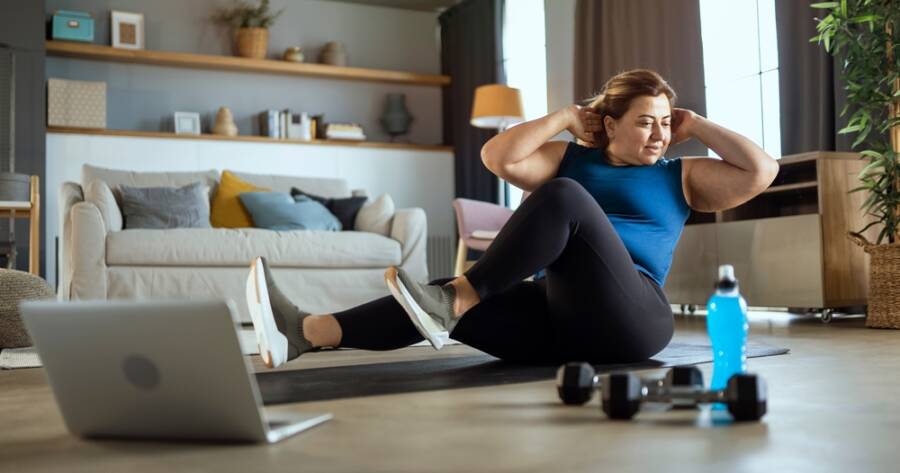Getting stronger doesn’t require a gym membership or expensive equipment. With just a little space and a few essential movements, you can build strength, improve endurance, and boost overall fitness from the comfort of your home. Strength training not only enhances muscle tone but also supports metabolism, bone health, and injury prevention. Whether you’re new to exercise or looking for an efficient way to stay active, a well-structured home workout can help you achieve your fitness goals.
Setting Up Your Home Workout Space
Creating a designated workout area makes it easier to stay consistent with your routine. You don’t need a fully equipped home gym—just a small space with enough room to move freely. A yoga mat, resistance bands, a set of dumbbells, or even household items like water bottles and backpacks filled with books can serve as makeshift weights.
Key considerations for your home gym setup:
- Flooring: Use a mat or carpeted area to protect joints during exercises.
- Lighting and Ventilation: A well-lit, airy space can enhance motivation and comfort.
- Minimal Distractions: Choose a quiet area where you can focus on your workout.
Once your space is ready, you can start incorporating simple, effective exercises into your routine.
Bodyweight Exercises to Build Strength
Bodyweight exercises are a great starting point for beginners because they require no equipment and help develop foundational strength. These movements engage multiple muscle groups and improve overall stability.
1. Squats
Squats strengthen the legs, glutes, and core while improving mobility.
How to do it:
- Stand with feet shoulder-width apart.
- Lower your hips as if sitting in a chair, keeping your chest up and knees aligned with your toes.
- Push through your heels to return to a standing position.
Beginner variation: Perform squats using a chair for support.
2. Push-Ups
Push-ups build upper body strength, focusing on the chest, shoulders, and triceps.
How to do it:
- Place hands slightly wider than shoulder-width on the floor.
- Lower your chest toward the ground while keeping your body in a straight line.
- Push back up to the starting position.
Beginner variation: Perform push-ups on your knees or against a wall for reduced resistance.
3. Glute Bridges
Glute bridges target the lower back, hamstrings, and glutes, helping improve hip stability.
How to do it:
- Lie on your back with knees bent and feet flat on the floor.
- Press through your heels and lift your hips until your body forms a straight line from shoulders to knees.
- Lower back down with control.
Beginner variation: Hold the position at the top for a few seconds to increase activation.
4. Plank
Planks engage the entire core, improving posture and stability.
How to do it:
- Rest on your forearms with legs extended, keeping your body in a straight line.
- Engage your core and hold for as long as possible without letting your hips sag.
Beginner variation: Start with a modified plank on your knees.
Adding Resistance for Progressive Strength Gains
Once bodyweight exercises become easier, incorporating resistance helps challenge muscles further. You can use:
- Resistance bands – Affordable and versatile for different strength levels.
- Dumbbells – Great for adding weight to traditional exercises.
- Household items – Water jugs, filled backpacks, or canned goods can work as makeshift weights.
1. Dumbbell Deadlifts
Strengthens hamstrings, glutes, and lower back.
- Hold a dumbbell in each hand, keeping a slight bend in your knees.
- Hinge at your hips, lowering the weights toward your feet.
- Squeeze your glutes to return to standing.
2. Banded Rows
Improves back strength and posture.
- Secure a resistance band under your feet.
- Pull the band toward your torso while keeping elbows close to your body.
- Slowly return to the starting position.
These simple modifications make strength training more effective while keeping workouts engaging.
Structuring Your Workout for Best Results
A well-balanced routine should target all major muscle groups and allow for proper recovery. Beginners can start with:
Workout Plan:
- 3-4 days per week for strength training.
- 3 sets of 10-15 reps per exercise.
- 30-60 seconds of rest between sets.
Example Full-Body Routine:
- Squats – 3 sets of 12 reps
- Push-Ups – 3 sets of 10 reps
- Glute Bridges – 3 sets of 15 reps
- Plank – 3 sets of 30 seconds
- Banded Rows – 3 sets of 12 reps
Gradually increasing reps, sets, or resistance helps ensure continuous progress.
From Couch to Confident
Strength training at home is a flexible and accessible way to build muscle and improve overall fitness. By starting with bodyweight exercises and gradually incorporating resistance, you can develop strength without the need for a gym. With consistency and proper form, home workouts can be just as effective as traditional gym routines. Finding a sustainable routine that fits your lifestyle is key to long-term success in strength training.

